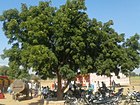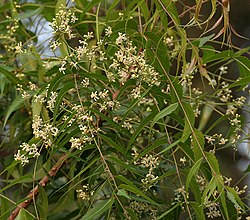Note: This is a project under development. The articles on this wiki are just being initiated and broadly incomplete. You can Help creating new pages.
Azadiracta indica - Nimba, Neem
Azadirachta indica also known as Neem. It is a tree in the mahogany family Meliaceae. It is one of the two species in the genus Azadirachta and is native to India and the Indian subcontinent including Nepal, Pakistan, Bangladesh, and Sri Lanka.
Uses
Skin diseases, Hair problems, Liver problems, Detoxify the blood, Fever, Blotches, Dental problems, Cough, Asthma, Ulcer, Piles, Skin disease, Worm infestation, Blood purifier, Wound.[1]
Parts Used
Chemical Composition
It contains Nimbandiol, Immobile, Nimocinol, Quercetin, and Beta-sitosterol And Two additional tetracyclic triterpenoids zafaral[2]
Common names
| Language | Common name |
|---|---|
| Kannada | Kirubevu, Turakabevu |
| Hindi | Neem |
| Malayalam | Ayurveppu, Nimbam |
| Tamil | Veppa, Vembu |
| Telugu | Vepa |
| Marathi | NA |
| Gujarathi | NA |
| Punjabi | NA |
| Kashmiri | NA |
| Sanskrit | Nimbaka, Pakvakrita |
| English | Neem tree, Yepa |
Properties
Reference: Dravya - Substance, Rasa - Taste, Guna - Qualities, Veerya - Potency, Vipaka - Post-digesion effect, Karma - Pharmacological activity, Prabhava - Therepeutics.
Dravya
Rasa
Tikta (Bitter), Kashaya (Astringent)
Guna
Laghu (Light), Ruksha (Dry)
Veerya
Sheeta (Cold)
Vipaka
Katu (Pungent)
Karma
Kapha, Pitta
Prabhava
Habit
Identification
Leaf
| Kind | Shape | Feature |
|---|---|---|
| Simple | Alternate | Leaves alternate, crowded near the end of branches, simply pinnate, 20-40 cm long, exstipulate, light green, with 2 pairs of glands at the base |
Flower
| Type | Size | Color and composition | Stamen | More information |
|---|---|---|---|---|
| Unisexual | 1-2 cm long | Greenishyellow | 5-20 | Flowers Season is June - August |
Fruit
| Type | Size | Mass | Appearance | Seeds | More information |
|---|---|---|---|---|---|
| 7–10 mm (0.28–0.4 in.) long pome | Fruit 1 (max. 2)-seeded drupe, ellipsoidal, 1-2 cm long, greenish, to yellow or purple when ripe | Each about half of the seed’s weight | Many | {{{6}}} |
Other features
List of Ayurvedic medicine in which the herb is used
Where to get the saplings
Mode of Propagation
How to plant/cultivate
Seeds are collected from June to August. It should be collected from 5 to 6 years old trees. Only fresh and ripe seeds should be collected. Seeds remain viable for a short period of 2 to 3 weeks only should be sown immediately[4]
Commonly seen growing in areas
Photo Gallery
References
- ↑ Karnataka Aushadhiya Sasyagalu By Dr.Maagadi R Gurudeva, Page no:267
- ↑ Pharmacology
- ↑ Botonic descroption
- ↑ Cultivation method
External Links
- Ayurvedic Herbs known to be helpful to treat Skin diseases
- Ayurvedic Herbs known to be helpful to treat Hair problems
- Ayurvedic Herbs known to be helpful to treat Liver problems
- Ayurvedic Herbs known to be helpful to treat Detoxify the blood
- Ayurvedic Herbs known to be helpful to treat Fever
- Ayurvedic Herbs known to be helpful to treat Blotches
- Ayurvedic Herbs known to be helpful to treat Dental problems
- Ayurvedic Herbs known to be helpful to treat Cough
- Ayurvedic Herbs known to be helpful to treat Asthma
- Ayurvedic Herbs known to be helpful to treat Ulcer
- Ayurvedic Herbs known to be helpful to treat Piles
- Ayurvedic Herbs known to be helpful to treat Skin disease
- Ayurvedic Herbs known to be helpful to treat Worm infestation
- Ayurvedic Herbs known to be helpful to treat Blood purifier
- Ayurvedic Herbs known to be helpful to treat Wound
- Herbs with Bark used in medicine
- Herbs with Leaves used in medicine
- Herbs with Seeds used in medicine
- Herbs with common name in Kannada
- Herbs with common name in Hindi
- Herbs with common name in Malayalam
- Herbs with common name in Tamil
- Herbs with common name in Telugu
- Herbs with common name in Sanskrit
- Herbs with common name in English
- Habit - Tree
- Index of Plants which can be propagated by Seeds
- Index of Plants which can be propagated by Cuttings
- Herbs that are commonly seen in the region of Tall grasslands
- Herbs that are commonly seen in the region of Meadows
- Herbs that are commonly seen in the region of Borders of forests and fields
- Herbs
- Meliaceae







